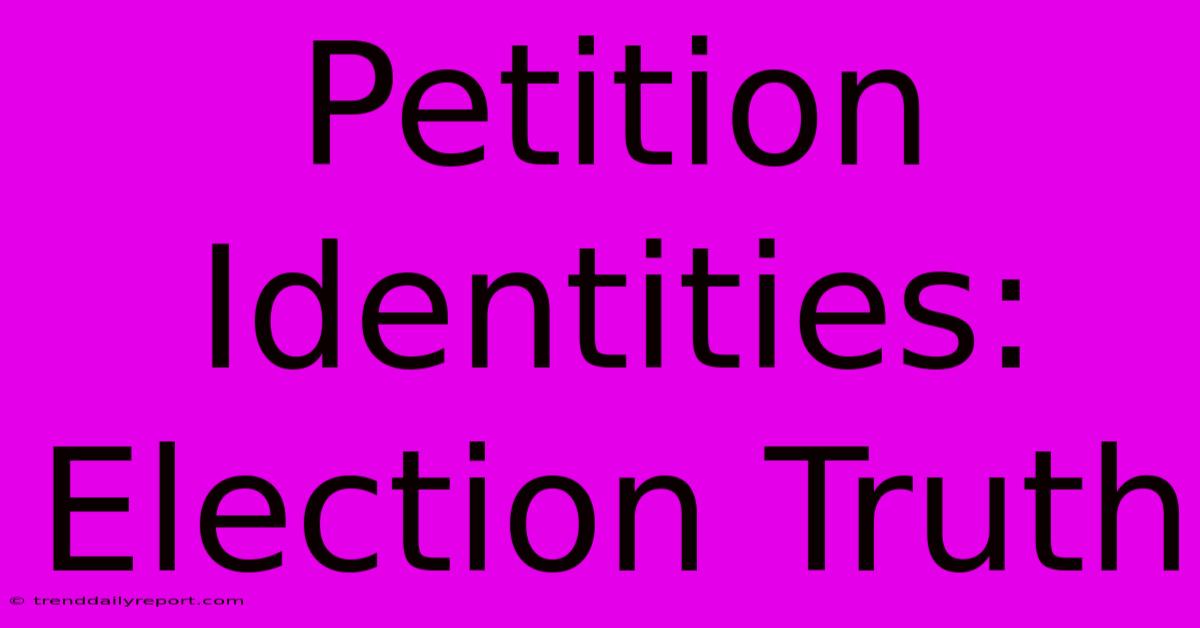Petition Identities: Election Truth

Discover more detailed and exciting information on our website. Click the link below to start your adventure: Visit Best Website Petition Identities: Election Truth. Don't miss out!
Table of Contents
Petition Identities: Unmasking the Truth Behind Election Petitions
Hey everyone, let's dive into something super important – election petitions and the identities hidden (or sometimes, not so hidden) within them. This is something I've been wrestling with for a while, both personally and professionally, so I wanted to share my thoughts and some hard-won lessons.
I’ll be honest, when I first started looking into election petition analysis, I was totally overwhelmed. It felt like navigating a dense jungle with no map. My initial attempts were, let's just say, less than stellar. I spent hours sifting through PDFs, chasing down dead ends, and generally feeling like I was banging my head against a brick wall. I even tried one petition analysis using only the names, and the result was completely unusable. I needed a better strategy.
The Importance of Identifying Petitioners
The whole point of analyzing election petitions, right? It's about understanding who's behind the challenges, what their motivations might be, and ultimately, whether the claims hold water. Identifying petitioners accurately is the FIRST step. It's like trying to solve a puzzle without knowing what the picture is supposed to look like – you're just spinning your wheels. You can't effectively assess the credibility of a petition if you don't know who's filing it.
So, what did I learn the hard way? A LOT. First, don't rely solely on the petition documents themselves. Often, the information provided is incomplete or deliberately obscured. Think of it like a game of hide-and-seek.
Going Beyond the Obvious: Data Sources and Verification
To really get to the bottom of things, I started using multiple data sources. Think of it as triangulation—using several sources of information to pinpoint a location. Here's what worked best for me:
-
Public Records: County clerk websites are gold mines. I found voter registration data, campaign finance disclosures (sometimes linked to petition signers), and even legal records related to previous lawsuits. It's tedious, but the information is often crucial.
-
Social Media: While not always reliable, social media can provide context. I've linked petition signers to their social media profiles, uncovering affiliations, political leanings, and even their own statements about the election. It's amazing what you can find.
-
News Articles and Reports: Local news outlets frequently cover election-related controversies. These stories often mention key players involved in petitions, providing additional details and verifying identities.
Pro Tip: Always cross-reference information. Don't assume anything. If something seems fishy, dig deeper. Multiple sources confirming the same information are key to accurate verification.
My Biggest Mistake (and How I Fixed It)
One time, I jumped to conclusions based on a single social media post. I thought I'd cracked the code, only to discover later that I'd misidentified someone – completely embarrassing. It taught me the importance of meticulous verification and the dangers of confirmation bias. You know what they say: "Garbage in, garbage out".
The Ethical Implications
This work isn't just about uncovering facts; it’s also about responsible data handling. Privacy is paramount. I always make sure my methods adhere to ethical guidelines and respect the privacy of individuals.
Bottom line: Uncovering the truth behind election petitions requires persistence, attention to detail, and a commitment to accuracy. It's not always easy, and it can be frustrating. But the ability to accurately identify petitioners and assess the legitimacy of their claims is essential for maintaining a healthy democracy. It's a tough job, but somebody's gotta do it! And hopefully, my experiences will help you do it better.

Thank you for visiting our website wich cover about Petition Identities: Election Truth. We hope the information provided has been useful to you. Feel free to contact us if you have any questions or need further assistance. See you next time and dont miss to bookmark.
Featured Posts
-
Only Fans Paid Kate Nash
Nov 27, 2024
-
Lithuania Dhl Plane Crash Sabotage Probe
Nov 27, 2024
-
Dangerous Driving Woman Pleads Guilty
Nov 27, 2024
-
New Faces In Vanderpump Rules Season 12
Nov 27, 2024
-
Brest Vs Barcelona Match Player Ratings
Nov 27, 2024
